Spatiotemporal Dynamics of Cultivated Land and Its Influences on Grain Production Potential in Hunan Province, China
Abstract
:1. Introduction
2. Materials and Methods
2.1. Study Area
2.2. Data Sources
2.3. Influence Mechanism of Cultivated Land Change on Grain Production
2.4. Methodology
2.4.1. Quantitative Methods for Calculating the Number and Structure Change
2.4.2. The Analysis Method of Spatial Variation Characteristics of Cultivated Land
2.4.3. Methodology for Estimating Grain Production Potential
2.4.4. Assessing the Impact of Cultivated Land Change on Grain Production Potential
3. Results
3.1. Overall Characteristics of Cultivated Land Change
3.2. Cultivated Land Change in Different Production Condition Zones
3.2.1. Changes in Cultivated Land at Different Altitudes
3.2.2. Changes in Cultivated Land at Different Slope Levels
3.2.3. Changes in Cultivated Land at Different Temperature Conditions
3.2.4. Changes in Cultivated Land under Different Rainfall Conditions
3.3. Impacts of Cultivated Land Change on GPP
3.3.1. Impact of Cultivated Land Quantity and Structure Change on Total GPP
3.3.2. Impact of Cultivated Land Conversion and Spatial Location Change on Total GPP
3.3.3. Impact of Cultivated Land Change on the Spatial Pattern of GPP
3.3.4. The Spatial Pattern of Sensitivity of GPP to Cultivated Land Change
4. Discussion
5. Conclusions
Author Contributions
Funding
Acknowledgments
Conflicts of Interest
References
- Rosenzweig, C.; Parry, M. Potential impact of climate change on world food supply. Nat. Cell Biol. 1994, 367, 133–138. [Google Scholar] [CrossRef]
- Armanda, D.T.; Guinée, J.B.; Tukker, A. The second green revolution: Innovative urban agriculture’s contribution to food security and sustainability—A review. Glob. Food Secur. 2019, 22, 13–24. [Google Scholar] [CrossRef]
- West, P.C.; Gerber, J.S.; Engstrom, P.M.; Mueller, N.D.; Brauman, K.A.; Carlson, K.M.; Cassidy, E.S.; Johnston, M.; Macdonald, G.K.; Ray, D.K.; et al. Leverage points for improving global food security and the environment. Science 2014, 345, 325–328. [Google Scholar] [CrossRef] [Green Version]
- Anderson, K.; Strutt, A. Food security policy options for China: Lessons from other countries. Food Policy 2014, 49, 50–58. [Google Scholar] [CrossRef]
- Fujimori, S.; Hasegawa, T.; Krey, V.; Riahi, K.; Bertram, C.; Bodirsky, B.L.; Bosetti, V.; Callen, J.; Després, J.; Doelman, J.; et al. A multi-model assessment of food security implications of climate change mitigation. Nat. Sustain. 2019, 2, 386–396. [Google Scholar] [CrossRef] [Green Version]
- Renard, D.; Tilman, D. National food production stabilized by crop diversity. Nat. Cell Biol. 2019, 571, 257–260. [Google Scholar] [CrossRef] [PubMed]
- Subramaniam, Y.; Masron, T.A.; Azman, N.H.N. Biofuels, environmental sustainability, and food security: A review of 51 countries. Energy Res. Soc. Sci. 2020, 68, 101549. [Google Scholar] [CrossRef]
- Smit, B.; Cai, Y. Climate change and agriculture in China. Glob. Environ. Chang. 1996, 6, 205–214. [Google Scholar] [CrossRef]
- Gandhi, V.P.; Zhou, Z. Food demand and the food security challenge with rapid economic growth in the emerging economies of India and China. Food Res. Int. 2014, 63, 108–124. [Google Scholar] [CrossRef]
- Koizumi, T. Biofuel and food security in China and Japan. Renew. Sustain. Energy Rev. 2013, 21, 102–109. [Google Scholar] [CrossRef]
- FAO. The State of Food and Agriculture; FAO: Rome, Italy, 2016; Available online: http://www.fao.org/3/a-i6030e.pdf (accessed on 25 May 2020).
- Swiss Agency for Development and Cooperation (SDC). Strategy 2017–2020 Global Programme Food Security (GPFS); Swiss Agency for Development and Cooperation (SDC): Berne, Switzerland, 2017. [Google Scholar]
- Long, H.; Ge, D.; Zhang, Y.; Tu, S.; Qu, Y.; Ma, L. Changing man-land interrelations in China’s farming area under urbanization and its implications for food security. J. Environ. Manag. 2018, 209, 440–451. [Google Scholar] [CrossRef] [PubMed]
- Huang, J.; Yang, G. Understanding recent challenges and new food policy in China. Glob. Food Secur. 2017, 12, 119–126. [Google Scholar] [CrossRef]
- Veeck, G.; Veeck, A.; Yu, H. Challenges of agriculture and food systems issues in China and the United States. Geogr. Sustain. 2020, 1, 109–117. [Google Scholar] [CrossRef]
- Deng, X.; Huang, J.; Rozelle, S.; Zhang, J.; Li, Z. Impact of urbanization on cultivated land changes in China. Land Use Policy 2015, 45, 1–7. [Google Scholar] [CrossRef]
- Felipe, J.; Bayudan-Dacuycuy, C.; Lanzafame, M. The declining share of agricultural employment in China: How fast? Struct. Chang. Econ. Dyn. 2016, 37, 127–137. [Google Scholar] [CrossRef]
- Liao, L.; Long, H.; Gao, X.; Ma, E. Effects of land use transitions and rural aging on agricultural production in China’s farming area: A perspective from changing labor employing quantity in the planting industry. Land Use Policy 2019, 88, 104152. [Google Scholar] [CrossRef]
- Khan, S.; Hanjra, M.A.; Mu, J. Water management and crop production for food security in China: A review. Agric. Water Manag. 2009, 96, 349–360. [Google Scholar] [CrossRef]
- Masud, M.B.; Wada, Y.; Goss, G.; Faramarzi, M. Global implications of regional grain production through virtual water trade. Sci. Total. Environ. 2019, 659, 807–820. [Google Scholar] [CrossRef]
- Lu, S.; Bai, X.; Li, W.; Wang, N. Impacts of climate change on water resources and grain production. Technol. Forecast. Soc. Chang. 2019, 143, 76–84. [Google Scholar] [CrossRef]
- Chen, S.; Gong, B. Response and adaptation of agriculture to climate change: Evidence from China. J. Dev. Econ. 2020, 148, 102557. [Google Scholar] [CrossRef]
- Wu, Y.; Shan, L.; Guo, Z.; Peng, Y. Cultivated land protection policies in China facing 2030: Dynamic balance system versus basic farmland zoning. Habitat Int. 2017, 69, 126–138. [Google Scholar] [CrossRef]
- Jiang, G.; Zhang, R.; Ma, W.; Zhou, D.; Wang, X.; He, X. Cultivated land productivity potential improvement in land consolidation schemes in Shenyang, China: Assessment and policy implications. Land Use Policy 2017, 68, 80–88. [Google Scholar] [CrossRef]
- Li, Y.; Wu, W.; Liu, Y. Land consolidation for rural sustainability in China: Practical reflections and policy implications. Land Use Policy 2018, 74, 137–141. [Google Scholar] [CrossRef]
- Tian, G.; Duan, J.; Yang, L. Spatio-temporal pattern and driving mechanisms of cropland circulation in China. Land Use Policy 2020, 100, 105118. [Google Scholar] [CrossRef]
- Song, W.; Pijanowski, B.C. The effects of China’s cultivated land balance program on potential land productivity at a national scale. Appl. Geogr. 2014, 46, 158–170. [Google Scholar] [CrossRef]
- Xin, L.; Li, X. China should not massively reclaim new farmland. Land Use Policy 2018, 72, 12–15. [Google Scholar] [CrossRef]
- Liu, T.; Liu, H.; Qi, Y. Construction land expansion and cultivated land protection in urbanizing China: Insights from national land surveys, 1996–2006. Habitat Int. 2015, 46, 13–22. [Google Scholar] [CrossRef]
- Li, T.; Long, H.; Zhang, Y.; Tu, S.; Ge, D.; Li, Y.; Hu, B. Analysis of the spatial mismatch of grain production and farmland resources in China based on the potential crop rotation system. Land Use Policy 2017, 60, 26–36. [Google Scholar] [CrossRef]
- Neumann, K.; Verburg, P.H.; Stehfest, E.; Müller, C. The yield gap of global grain production: A spatial analysis. Agric. Syst. 2010, 103, 316–326. [Google Scholar] [CrossRef]
- Yang, X.; Cheng, C.; Li, Y. Effect of cropland occupation and supplement on light-temperature potential productivity in China from 2000 to 2008. Chin. Geogr. Sci. 2010, 20, 536–544. [Google Scholar] [CrossRef] [Green Version]
- Chai, J.; Wang, Z.; Yang, J.; Zhang, L. Analysis for spatial-temporal changes of grain production and farmland resource: Evidence from Hubei Province, central China. J. Clean. Prod. 2019, 207, 474–482. [Google Scholar] [CrossRef]
- Liu, Y.; Zhang, Y.; Guo, L. Towards realistic assessment of cultivated land quality in an ecologically fragile environment: A satellite imagery-based approach. Appl. Geogr. 2010, 30, 271–281. [Google Scholar] [CrossRef]
- Wang, J.; Zhang, Z.; Liu, Y. Spatial shifts in grain production increases in China and implications for food security. Land Use Policy 2018, 74, 204–213. [Google Scholar] [CrossRef]
- Pfister, S.; Bayer, P.; Koehler, A.; Hellweg, S. Environmental Impacts of Water Use in Global Crop Production: Hotspots and Trade-Offs with Land Use. Environ. Sci. Technol. 2011, 45, 5761–5768. [Google Scholar] [CrossRef] [PubMed]
- Kell, S.; Qin, H.; Chen, B.; Lloyd, J.; Wei, W.; Kang, D.; Maxted, N. China’s crop wild relatives: Diversity for agriculture and food security. Agric. Ecosyst. Environ. 2015, 209, 138–154. [Google Scholar] [CrossRef]
- Gao, B.; Ju, X.; Meng, Q.; Cui, Z.; Christie, P.; Chen, X.; Zhang, F. The impact of alternative cropping systems on global warming potential, grain yield and groundwater use. Agric. Ecosyst. Environ. 2015, 203, 46–54. [Google Scholar] [CrossRef]
- Norse, D.; Ju, X. Environmental costs of China’s food security. Agric. Ecosyst. Environ. 2015, 209, 5–14. [Google Scholar] [CrossRef]
- Chun, J.; Li, S.; Wang, Q.; Lee, W.-S.; Lee, E.-J.; Horstmann, N.; Park, H.; Veasna, T.; Vanndy, L.; Pros, K.; et al. Assessing rice productivity and adaptation strategies for Southeast Asia under climate change through multi-scale crop modeling. Agric. Syst. 2016, 143, 14–21. [Google Scholar] [CrossRef]
- Wu, W.; Yu, Q.; You, L.; Chen, K.; Tang, H.; Liu, J. Global cropping intensity gaps: Increasing food production without cropland expansion. Land Use Policy 2018, 76, 515–525. [Google Scholar] [CrossRef]
- Sheng, Y.; Chancellor, W. Exploring the relationship between farm size and productivity: Evidence from the Australian grains industry. Food Policy 2019, 84, 196–204. [Google Scholar] [CrossRef]
- Yin, G.; Lin, Z.; Jiang, X.; Yan, H.; Wang, X. Spatiotemporal differentiations of arable land use intensity—A comparative study of two typical grain producing regions in northern and southern China. J. Clean. Prod. 2019, 208, 1159–1170. [Google Scholar] [CrossRef]
- Fei, L.; Meijun, Z.; Jiaqi, S.; Zehui, C.; Xiaoli, W.; Jiuchun, Y. Maize, wheat and rice production potential changes in China under the background of climate change. Agric. Syst. 2020, 182, 102853. [Google Scholar] [CrossRef]
- Singirankabo, U.A.; Ertsen, M.W. Relations between Land Tenure Security and Agricultural Productivity: Exploring the Effect of Land Registration. Land 2020, 9, 138. [Google Scholar] [CrossRef]
- Pan, T.; Du, G.; Dong, J.; Kuang, W.; De Maeyer, P.; Kurban, A. Divergent changes in cropping patterns and their effects on grain production under different agro-ecosystems over high latitudes in China. Sci. Total. Environ. 2019, 659, 314–325. [Google Scholar] [CrossRef] [PubMed]
- Saddique, Q.; Liu, D.L.; Wang, B.; Feng, P.; He, J.; Ajaz, A.; Ji, J.; Xu, J.; Zhang, C.; Cai, H. Modelling future climate change impacts on winter wheat yield and water use: A case study in Guanzhong Plain, northwestern China. Eur. J. Agron. 2020, 119, 126113. [Google Scholar] [CrossRef]
- Smith, P.; Gregory, P.J. Climate change and sustainable food production. Proc. Nutr. Soc. 2012, 72, 21–28. [Google Scholar] [CrossRef] [PubMed] [Green Version]
- Meng, Q.; Hou, P.; Wu, L.; Chen, X.; Cui, Z.; Zhang, F. Understanding production potentials and yield gaps in intensive maize production in China. Field Crop. Res. 2013, 143, 91–97. [Google Scholar] [CrossRef] [Green Version]
- Liu, L.; Chen, X.; Xu, X.; Wang, Y.; Li, S.; Fu, Y. Changes in Production Potential in China in Response to Climate Change from 1960 to 2010. Adv. Meteorol. 2014, 2014, 1–10. [Google Scholar] [CrossRef]
- Jin, G.; Li, Z.; Deng, X.; Yang, J.; Chen, D.; Li, W. An analysis of spatiotemporal patterns in Chinese agricultural productivity between 2004 and 2014. Ecol. Indic. 2019, 105, 591–600. [Google Scholar] [CrossRef]
- Fischer, G.; Nachtergaele, F.; Prieler, S.; Van Velthuizen, H.; Verelst, L.; Wiberg, D. Global Agro-Ecological Zones Assessment for Agriculture (GAEZ 2008); IIASA: Laxenburg, Austria; FAO: Rome, Italy, 2008. [Google Scholar]
- Fischer, G.; van Velthuizen, H.T.; Nachtergaele, F.O. Global Agro-Ecological Zones Assessment: Methodology and Results; IIASA: Laxenburg, Austria, 2000. [Google Scholar]
- Fischer, G.; van Velthuizen, H.T.; Shah, M.M.; Nachtergaele, F.O. Global Agro-Ecological Assessment for Agriculture in the 21st Century: Methodology and Results. Research Report RR-02-02; IIASA: Laxenburg, Austria, 2002. [Google Scholar]
- Deng, G. The seasonal distribution of climatic potential productivity and the optimum seeding time of maize. Acta Meteorol. Sin. 1986, 44, 192–198, (In Chinese with English abstract). [Google Scholar]
- Deng, X.; Gibson, J.; Wang, P. Management of trade-offs between cultivated land conversions and land productivity in Shandong Province. J. Clean. Prod. 2017, 142, 767–774. [Google Scholar] [CrossRef]
- Zabel, F.; Delzeit, R.; Schneider, J.M.; Seppelt, R.; Mauser, W.; Václavík, T. Global impacts of future cropland expansion and intensification on agricultural markets and biodiversity. Nat. Commun. 2019, 10, 1–10. [Google Scholar] [CrossRef] [PubMed] [Green Version]
- Bratley, K.; Ghoneim, E. Modeling Urban Encroachment on the Agricultural Land of the Eastern Nile Delta Using Remote Sensing and a GIS-Based Markov Chain Model. Land 2018, 7, 114. [Google Scholar] [CrossRef] [Green Version]
- Müller, B.; Hoffmann, F.; Heckelei, T.; Müller, C.; Hertel, T.W.; Polhill, J.G.; Van Wijk, M.; Achterbosch, T.; Alexander, P.; Brown, C.; et al. Modelling food security: Bridging the gap between the micro and the macro scale. Glob. Environ. Chang. 2020, 63, 102085. [Google Scholar] [CrossRef]
- Van Dijk, M.; Gramberger, M.; Laborde, D.; Mandryk, M.; Shutes, L.; Stehfest, E.; Valin, H.; Faradsch, K. Stakeholder-designed scenarios for global food security assessments. Glob. Food Secur. 2020, 24, 100352. [Google Scholar] [CrossRef]
- Liu, H.; Tang, L.; Hu, B.; Liu, G.; Wang, Y. A dataset of reconstructed photosynthetically active radiation in China (1961–2014). Sci. Data Bank 2017. [Google Scholar] [CrossRef]
- Liu, Y.; Wang, J.; Guo, L. The spatial-temporal changes of grain production and arable land in China. Sci. Agric. Sin. 2009, 42, 4269–4274, (In Chinese with English abstract). [Google Scholar]
- Li, Y.; Yang, X.; Cheng, C.; Wang, J. Spatial Features of Occupation and Supplement Cropland Basedon Topographic Factors in China from 2008–2010. Resour. Sci. 2012, 34, 1671–1680, (In Chinese with English abstract). [Google Scholar]
- Sun, W.; Guo, C.; Zhu, Y. Average Soil Potential Productivity of Hunan Province, China, 1981–2010. GCdataPR 2020, 69, 90–94. [Google Scholar] [CrossRef]
- Cerni, P. Global Shift: Transforming the World Economy, 3rd Edition. Rev. Radic. Politi Econ. 2003, 35, 388–390. [Google Scholar] [CrossRef]
- Bigot, J.; Klein, T. Consistent estimation of a population barycenter in the Wasserstein space. Hosp. Med. 2012, 63, 238–239. [Google Scholar] [CrossRef]
- Zhang, Y.; Li, X.; Song, W. Determinants of cropland abandonment at the parcel, household and village levels in mountain areas of China: A multi-level analysis. Land Use Policy 2014, 41, 186–192. [Google Scholar] [CrossRef]
- Smaliychuk, A.; Müller, D.; Prishchepov, A.V.; Levers, C.; Kruhlov, I.; Kuemmerle, T. Recultivation of abandoned agricultural lands in Ukraine: Patterns and drivers. Glob. Environ. Chang. 2016, 38, 70–81. [Google Scholar] [CrossRef]
- Suziedelyte-Visockiene, J.; Tumeliene, E.; Maliene, V. Analysis and identification of abandoned agricultural land using remote sensing methodology. Land Use Policy 2019, 82, 709–715. [Google Scholar] [CrossRef]
- The National People’s Congress. Land Administration Law of the People’s Republic of China, 2019. Available online: http://www.npc.gov.cn/npc/c30834/201909/d1e6c1a1eec345eba23796c6e8473347.shtml (accessed on 5 September 2019).
- Wang, N.; Reidsma, P.; Pronk, A.A.; de Wit, A.J.; van Ittersum, M.K. Can potato add to China’s food self-sufficiency? The scope for increasing potato production in China. Eur. J. Agron. 2018, 101, 20–29. [Google Scholar] [CrossRef]
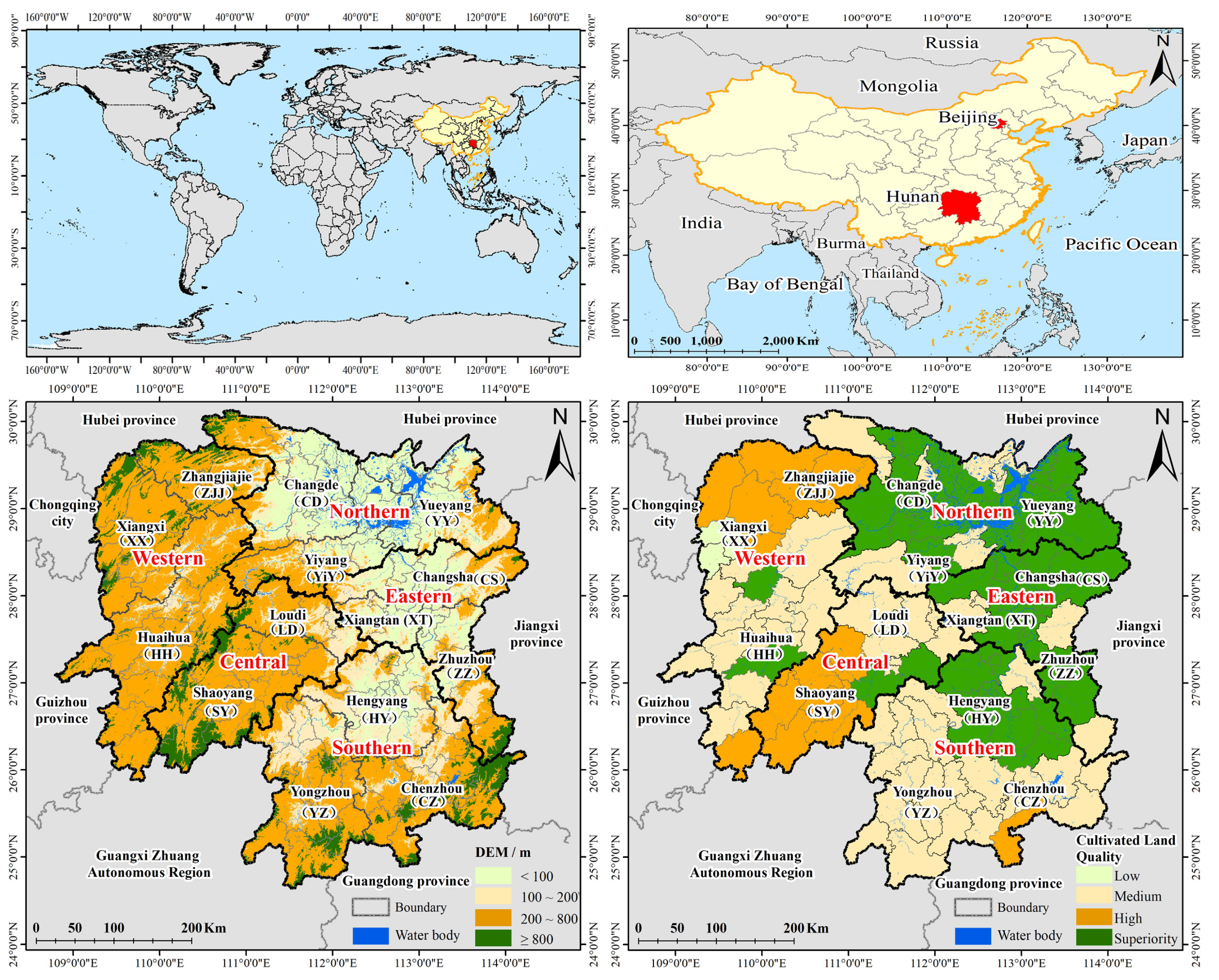
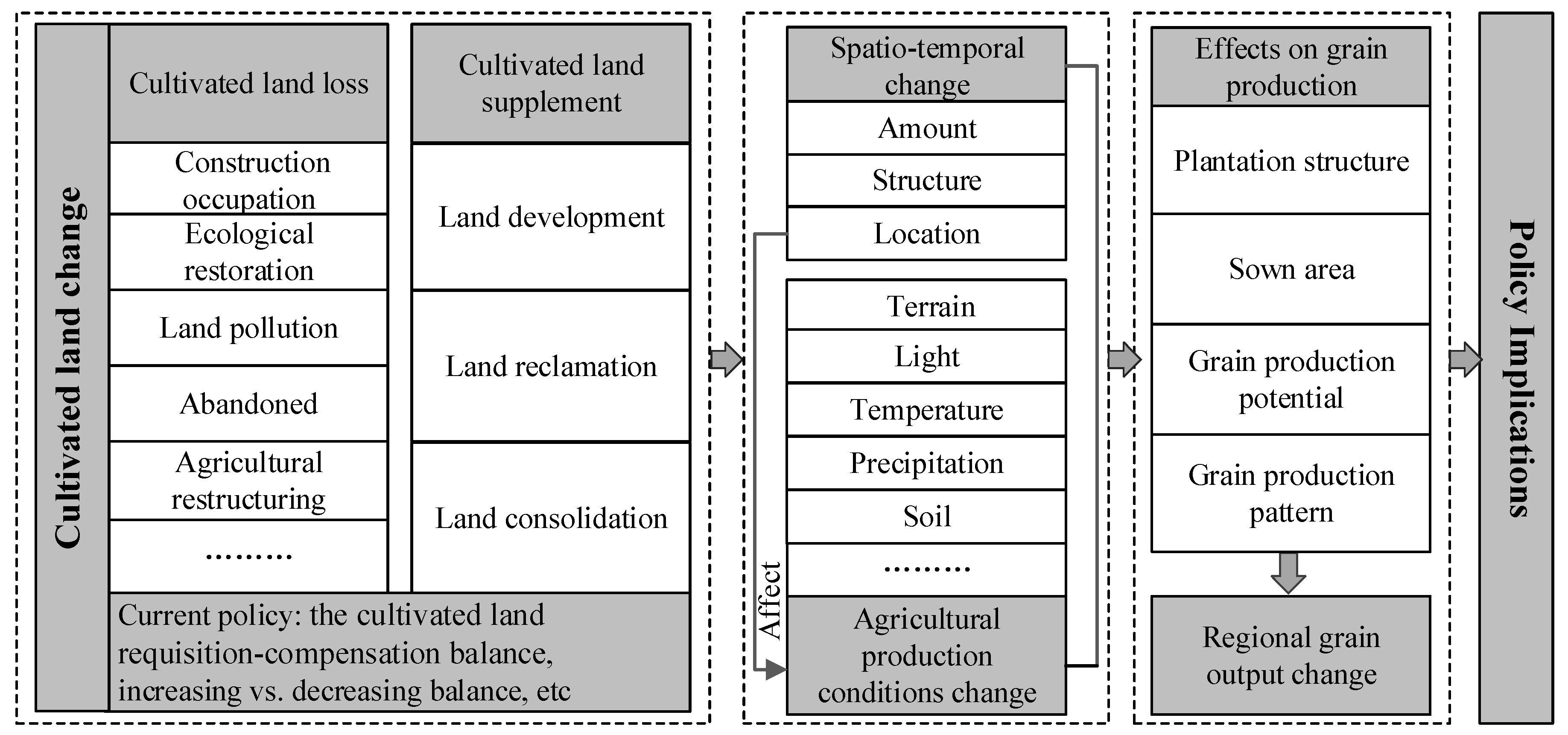
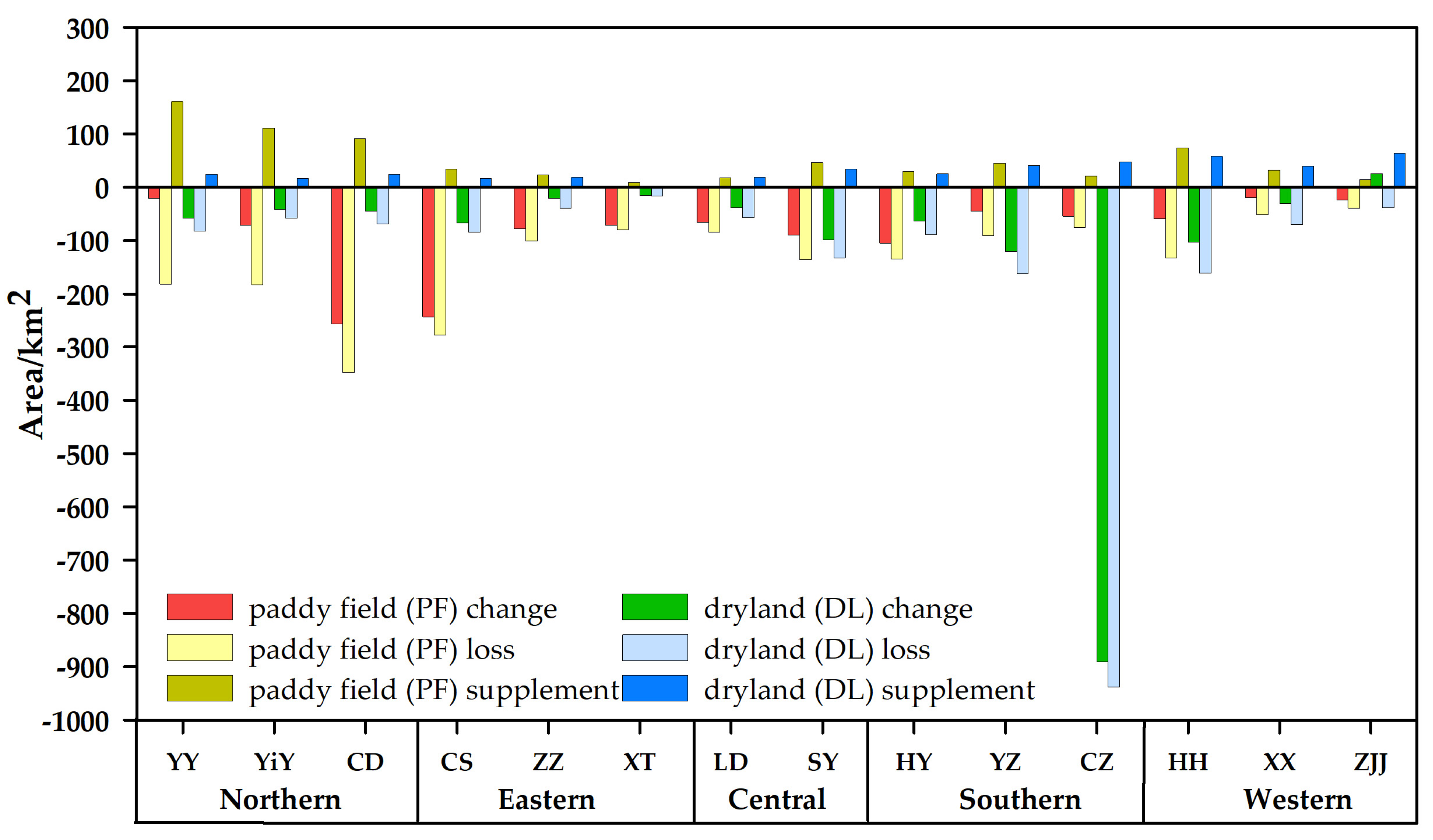
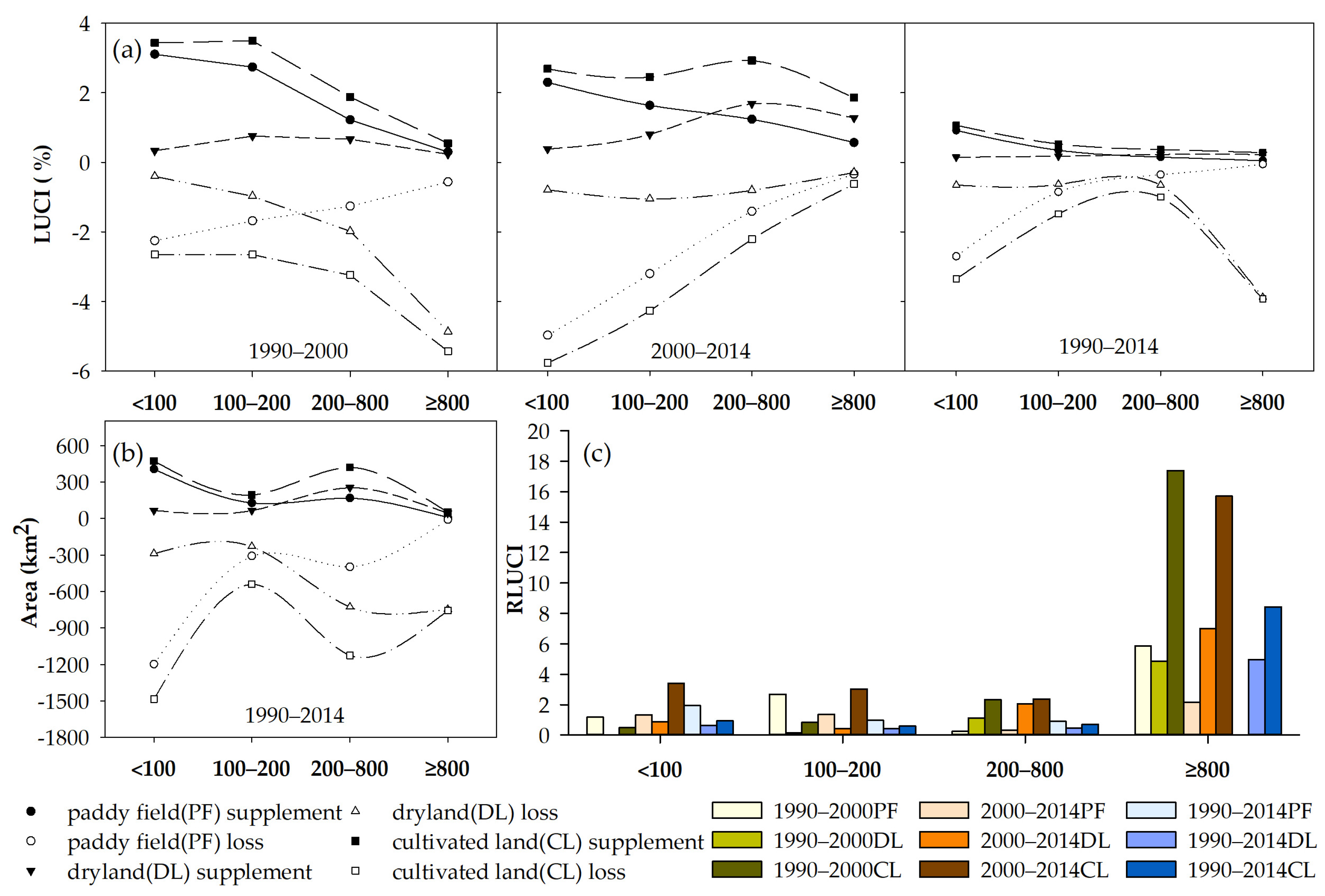
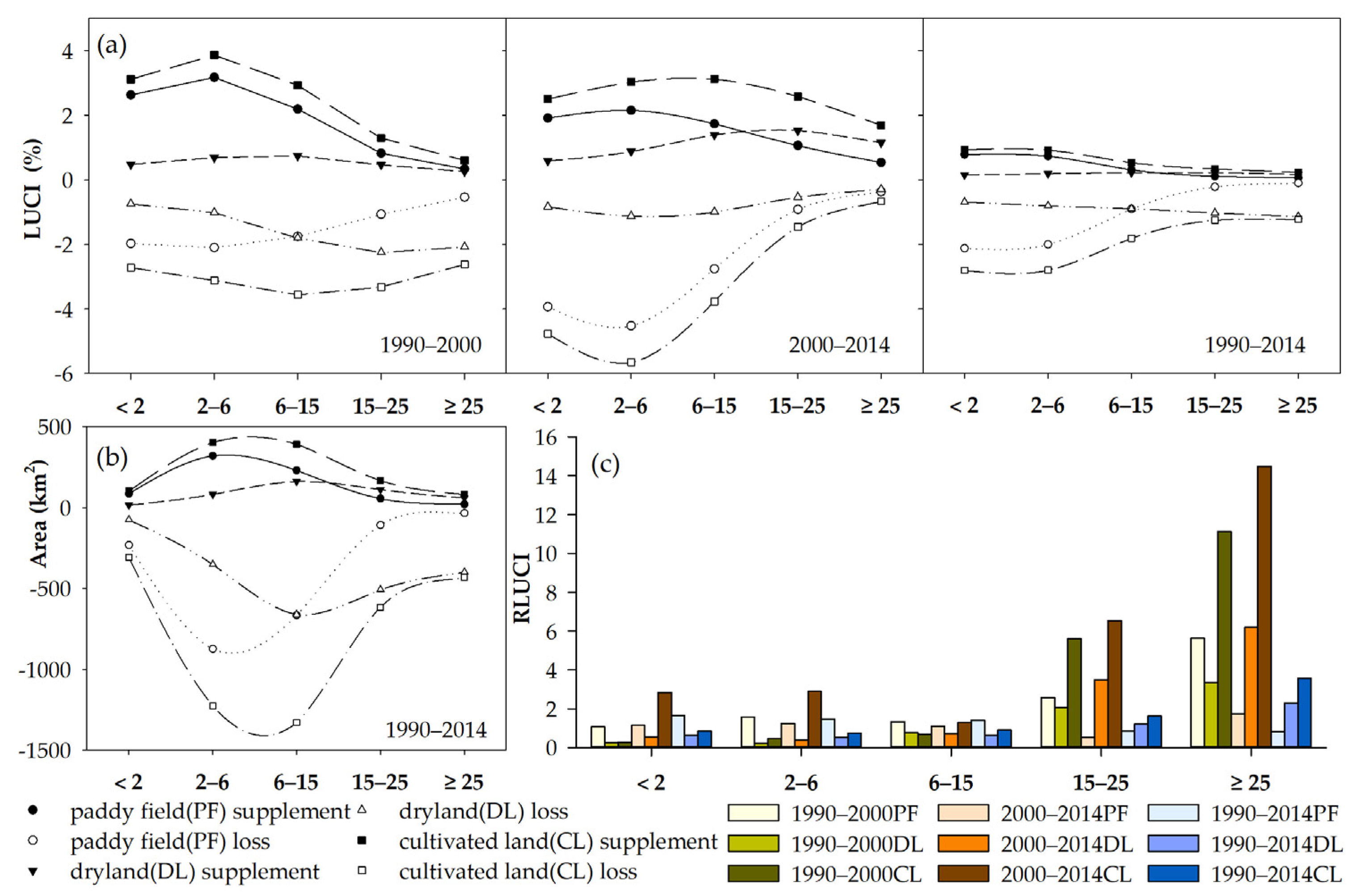
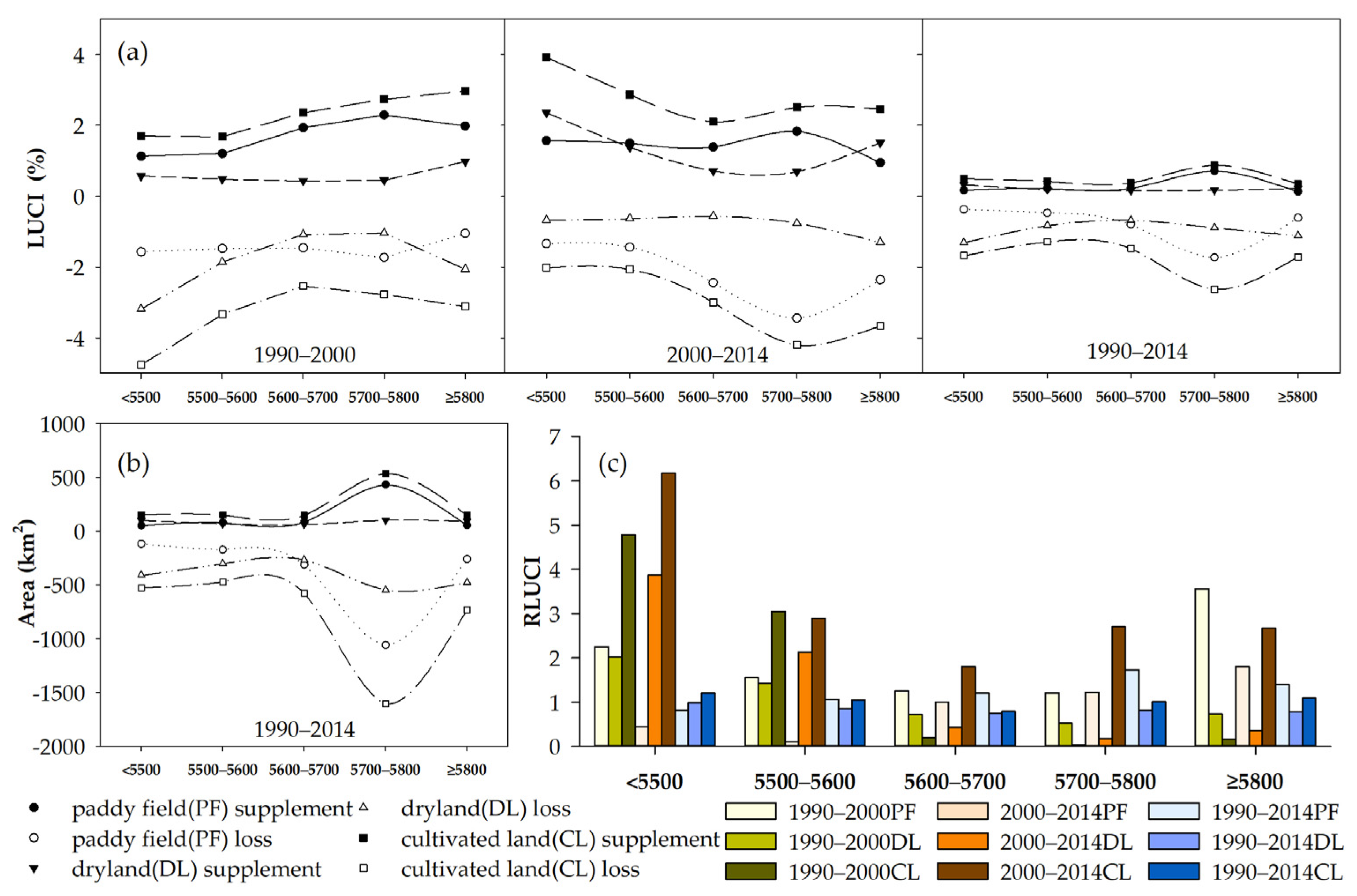
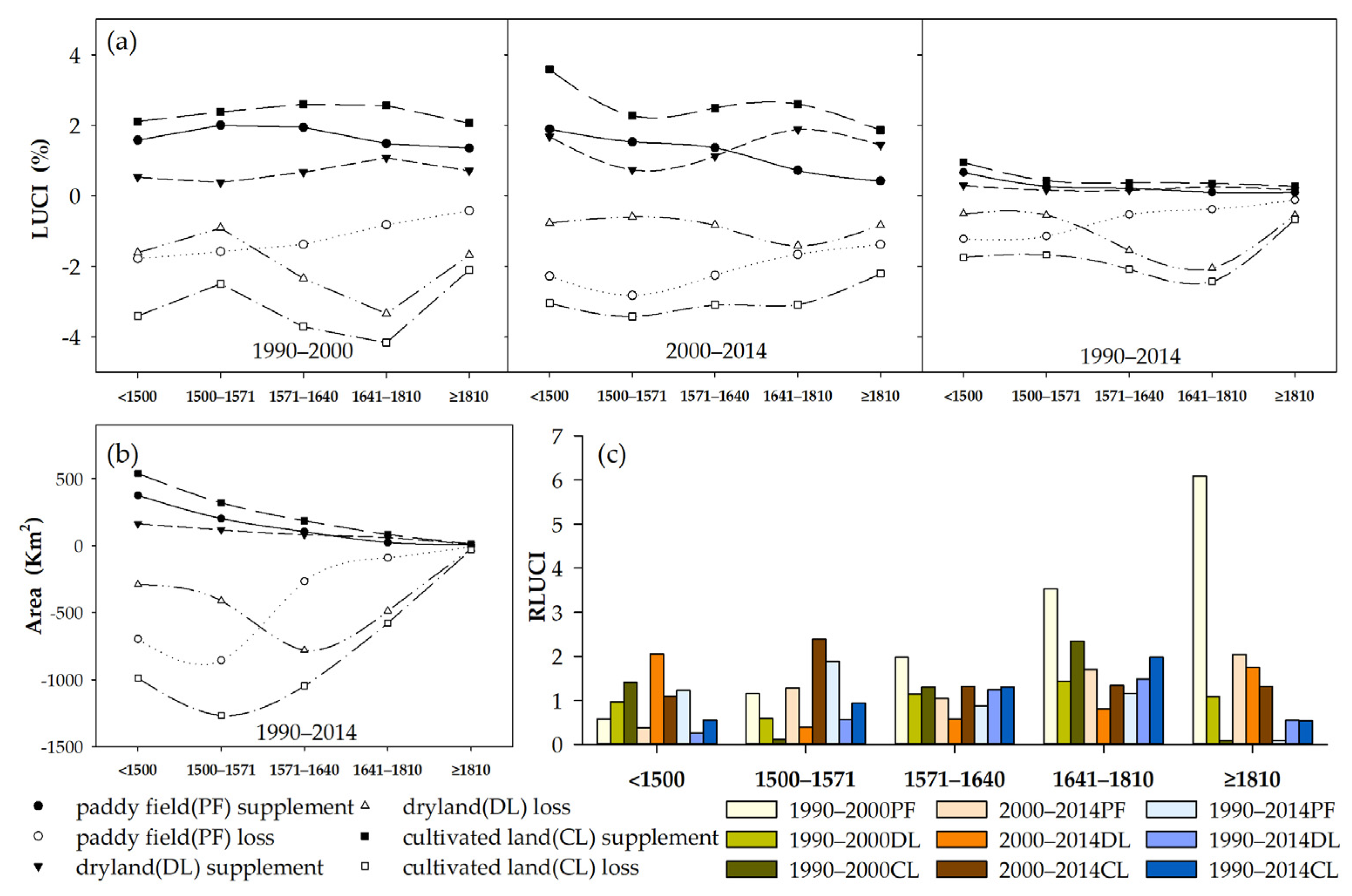
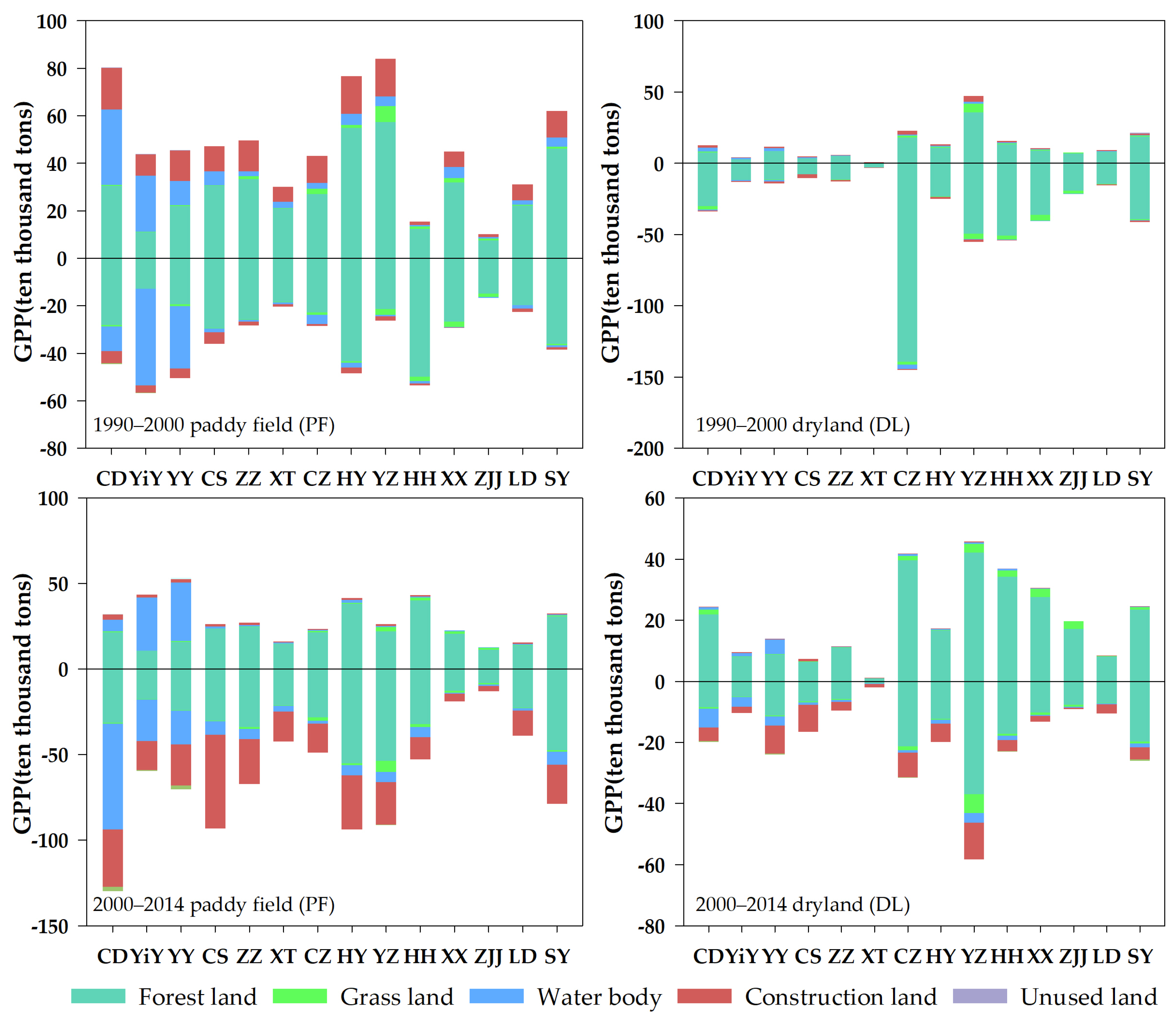
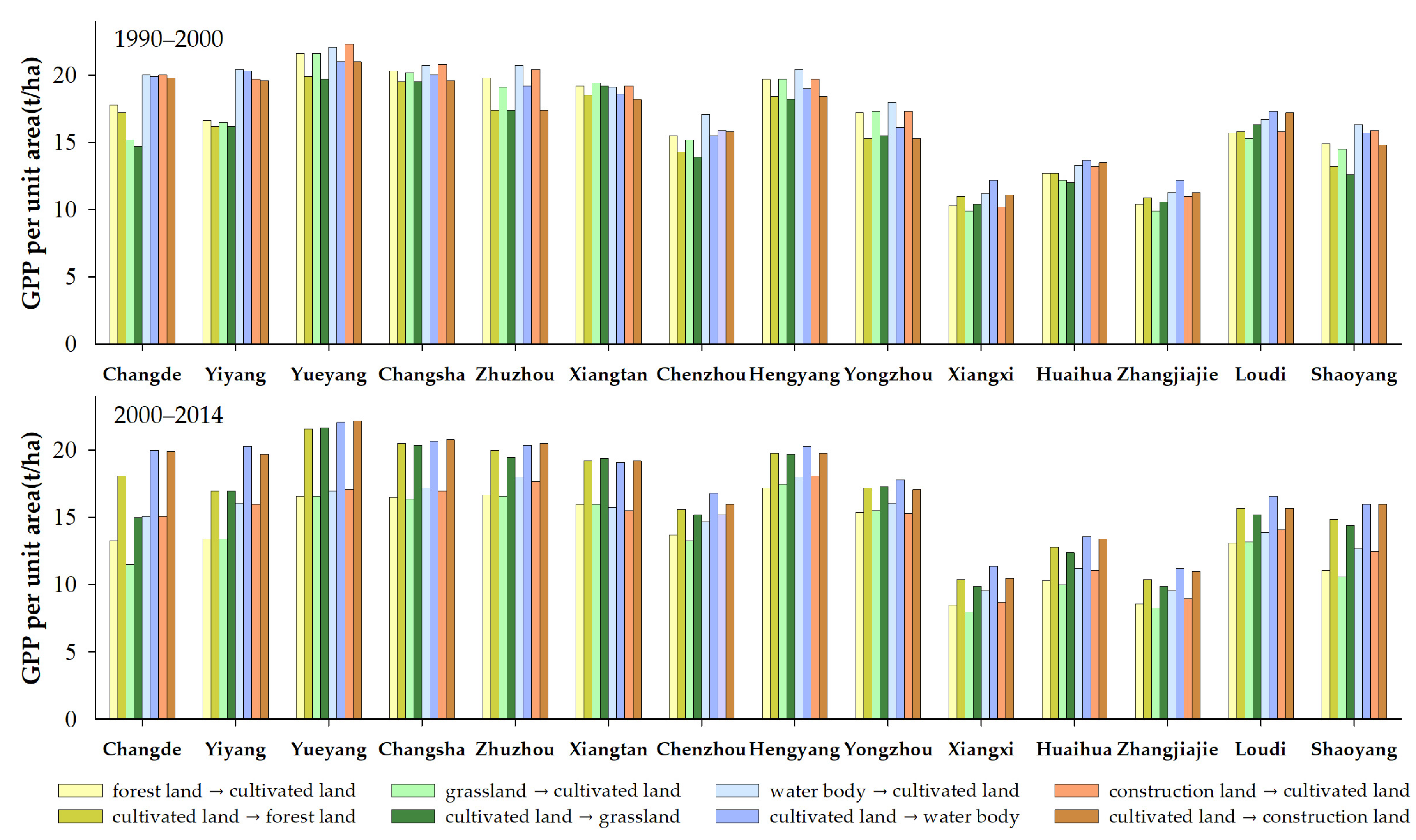
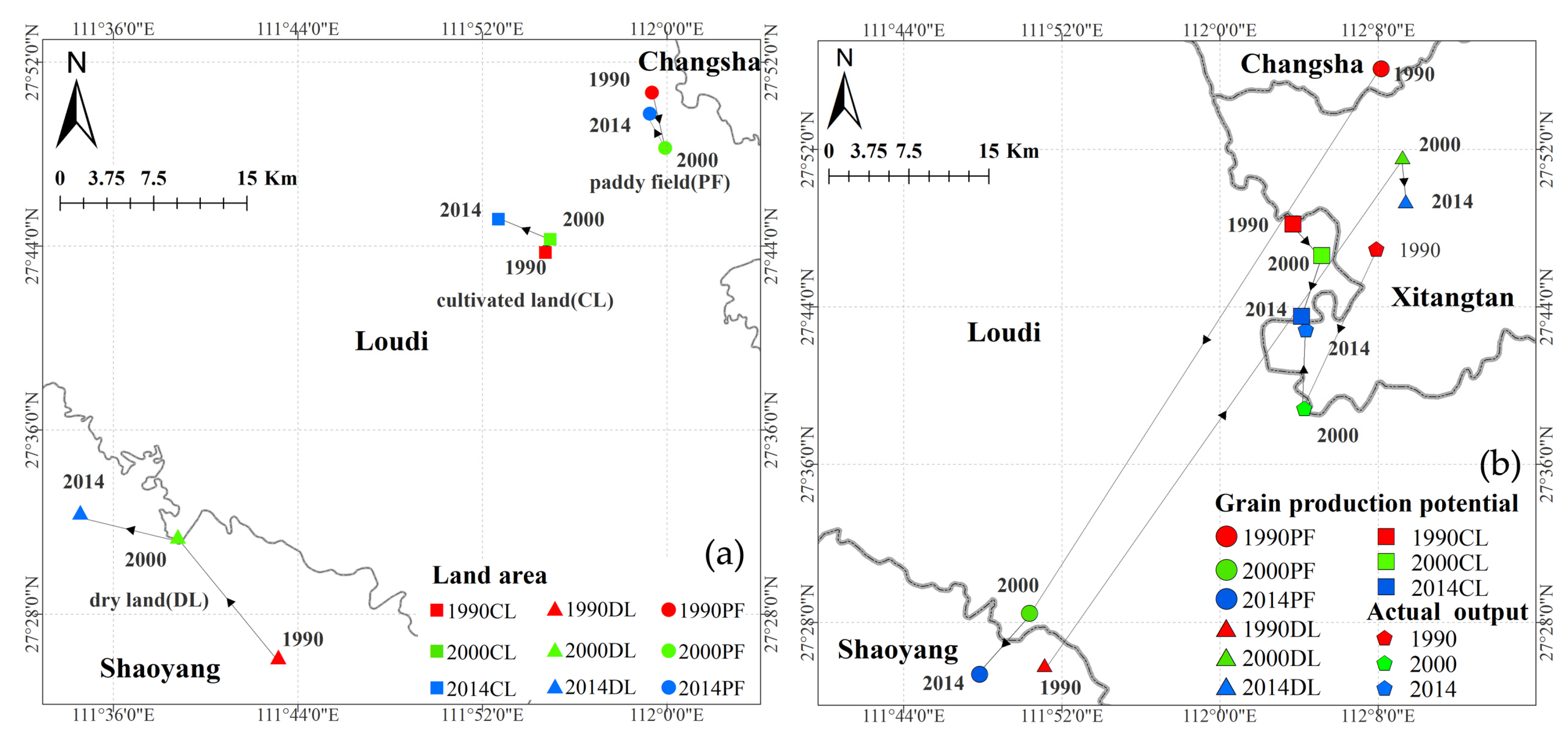

| First Classification | Second Classification | First Classification | Second Classification |
|---|---|---|---|
| Cultivated land | Paddy field Dryland | Forest land | Woodland shrubland Open forest land Others |
| Grassland | High-cover grassland Medium-cover grassland Low-cover grassland | Waterbody | River Lake Reservoir pond Permanent ice and snow Tidal flat Beach land |
| Construction land | Urban land Rural residential land Others | Unused land | Sandy land Gobi Saline land marshland Bare land Bare rock ground Others |
| Cities | Paddy Field/Million tons, % | Dryland/Million tons, % | ||||||||||
|---|---|---|---|---|---|---|---|---|---|---|---|---|
| 1990 | 2000 | 2014 | R1990–2000 | R2000–2014 | R1990–2014 | 1990 | 2000 | 2014 | R1990–2000 | R2000–2014 | R1990–2014 | |
| Changde | 12.16 | 12.86 | 9.01 | 5.81 | −29.96 | −25.89 | 2.15 | 1.91 | 1.57 | −10.81 | −18.19 | −27.03 |
| Yiyang | 7.48 | 7.32 | 5.85 | −2.08 | −20.06 | −21.73 | 0.82 | 0.72 | 0.61 | −11.44 | −15.46 | −25.13 |
| Yueyang | 8.87 | 9.40 | 7.17 | 6.02 | −23.70 | −19.11 | 2.10 | 2.24 | 1.74 | 6.38 | −22.48 | −17.53 |
| Changsha | 6.32 | 6.81 | 4.98 | 7.81 | −26.95 | −21.25 | 1.01 | 0.98 | 0.77 | −2.64 | −21.13 | −23.21 |
| Zhuzhou | 4.25 | 5.30 | 4.13 | 24.73 | −22.01 | −2.72 | 0.95 | 0.85 | 0.87 | −10.83 | 2.47 | −8.63 |
| Xiangtan | 3.21 | 3.45 | 2.69 | 7.48 | −21.89 | −16.04 | 0.18 | 0.15 | 0.14 | −13.08 | −10.93 | −22.58 |
| Hengyang | 8.00 | 9.29 | 7.67 | 16.18 | −17.43 | −4.07 | 3.07 | 2.72 | 2.51 | −11.51 | −7.83 | −18.43 |
| Chenzhou | 3.53 | 4.02 | 3.36 | 13.78 | −16.43 | −4.91 | 3.24 | 2.02 | 1.97 | −37.48 | −2.62 | −39.12 |
| Yongzhou | 5.96 | 7.48 | 5.97 | 25.51 | −20.13 | 0.24 | 3.99 | 3.98 | 3.65 | −0.05 | −8.41 | −8.45 |
| Huaihua | 3.92 | 3.94 | 3.16 | 0.48 | −19.65 | −19.27 | 2.40 | 1.90 | 1.82 | −20.66 | −4.17 | −23.96 |
| Xiangxi | 1.72 | 1.53 | 1.32 | −10.73 | −13.74 | −22.99 | 1.55 | 1.17 | 1.17 | −24.70 | 0.36 | −24.43 |
| Zhangjiajie | 1.33 | 1.26 | 1.05 | −5.02 | −17.07 | −21.23 | 1.10 | 0.89 | 0.90 | −19.00 | 0.50 | −18.59 |
| Loudi | 3.72 | 3.78 | 3.01 | 1.60 | −20.26 | −18.99 | 1.17 | 1.08 | 0.90 | −7.05 | −16.84 | −22.70 |
| Shaoyang | 5.68 | 7.31 | 5.08 | 28.71 | −30.59 | −10.67 | 3.13 | 2.46 | 2.19 | −21.68 | −10.99 | −30.29 |
| Total | 76.13 | 83.76 | 64.46 | 10.02 | −23.04 | −15.33 | 26.85 | 23.09 | 20.80 | −14.01 | −9.92 | −22.54 |
Publisher’s Note: MDPI stays neutral with regard to jurisdictional claims in published maps and institutional affiliations. |
© 2020 by the authors. Licensee MDPI, Basel, Switzerland. This article is an open access article distributed under the terms and conditions of the Creative Commons Attribution (CC BY) license (http://creativecommons.org/licenses/by/4.0/).
Share and Cite
Yu, D.; Hu, S.; Tong, L.; Xia, C. Spatiotemporal Dynamics of Cultivated Land and Its Influences on Grain Production Potential in Hunan Province, China. Land 2020, 9, 510. https://doi.org/10.3390/land9120510
Yu D, Hu S, Tong L, Xia C. Spatiotemporal Dynamics of Cultivated Land and Its Influences on Grain Production Potential in Hunan Province, China. Land. 2020; 9(12):510. https://doi.org/10.3390/land9120510
Chicago/Turabian StyleYu, De, Shougeng Hu, Luyi Tong, and Cong Xia. 2020. "Spatiotemporal Dynamics of Cultivated Land and Its Influences on Grain Production Potential in Hunan Province, China" Land 9, no. 12: 510. https://doi.org/10.3390/land9120510






